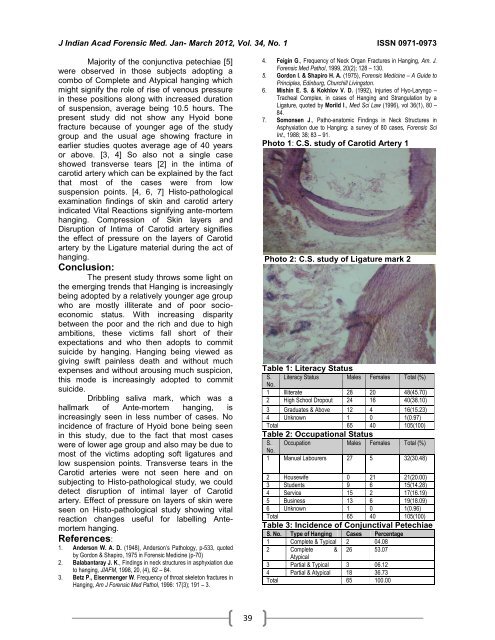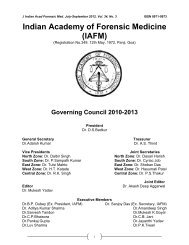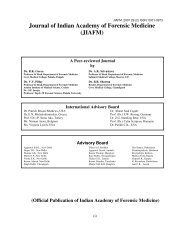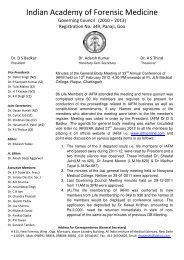Indian Academy of Forensic Medicine (IAFM) - Official website of IAFM
Indian Academy of Forensic Medicine (IAFM) - Official website of IAFM
Indian Academy of Forensic Medicine (IAFM) - Official website of IAFM
Create successful ePaper yourself
Turn your PDF publications into a flip-book with our unique Google optimized e-Paper software.
J <strong>Indian</strong> Acad <strong>Forensic</strong> Med. Jan- March 2012, Vol. 34, No. 1 ISSN 0971-0973<br />
Majority <strong>of</strong> the conjunctiva petechiae [5]<br />
were observed in those subjects adopting a<br />
combo <strong>of</strong> Complete and Atypical hanging which<br />
might signify the role <strong>of</strong> rise <strong>of</strong> venous pressure<br />
in these positions along with increased duration<br />
<strong>of</strong> suspension, average being 10.5 hours. The<br />
present study did not show any Hyoid bone<br />
fracture because <strong>of</strong> younger age <strong>of</strong> the study<br />
group and the usual age showing fracture in<br />
earlier studies quotes average age <strong>of</strong> 40 years<br />
or above. [3, 4] So also not a single case<br />
showed transverse tears [2] in the intima <strong>of</strong><br />
carotid artery which can be explained by the fact<br />
that most <strong>of</strong> the cases were from low<br />
suspension points. [4, 6, 7] Histo-pathological<br />
examination findings <strong>of</strong> skin and carotid artery<br />
indicated Vital Reactions signifying ante-mortem<br />
hanging. Compression <strong>of</strong> Skin layers and<br />
Disruption <strong>of</strong> Intima <strong>of</strong> Carotid artery signifies<br />
the effect <strong>of</strong> pressure on the layers <strong>of</strong> Carotid<br />
artery by the Ligature material during the act <strong>of</strong><br />
hanging.<br />
Conclusion:<br />
The present study throws some light on<br />
the emerging trends that Hanging is increasingly<br />
being adopted by a relatively younger age group<br />
who are mostly illiterate and <strong>of</strong> poor socioeconomic<br />
status. With increasing disparity<br />
between the poor and the rich and due to high<br />
ambitions, these victims fall short <strong>of</strong> their<br />
expectations and who then adopts to commit<br />
suicide by hanging. Hanging being viewed as<br />
giving swift painless death and without much<br />
expenses and without arousing much suspicion,<br />
this mode is increasingly adopted to commit<br />
suicide.<br />
Dribbling saliva mark, which was a<br />
hallmark <strong>of</strong> Ante-mortem hanging, is<br />
increasingly seen in less number <strong>of</strong> cases. No<br />
incidence <strong>of</strong> fracture <strong>of</strong> Hyoid bone being seen<br />
in this study, due to the fact that most cases<br />
were <strong>of</strong> lower age group and also may be due to<br />
most <strong>of</strong> the victims adopting s<strong>of</strong>t ligatures and<br />
low suspension points. Transverse tears in the<br />
Carotid arteries were not seen here and on<br />
subjecting to Histo-pathological study, we could<br />
detect disruption <strong>of</strong> intimal layer <strong>of</strong> Carotid<br />
artery. Effect <strong>of</strong> pressure on layers <strong>of</strong> skin were<br />
seen on Histo-pathological study showing vital<br />
reaction changes useful for labelling Antemortem<br />
hanging.<br />
References:<br />
1. Anderson W. A. D. (1948), Anderson’s Pathology, p-533, quoted<br />
by Gordon & Shapiro, 1975 in <strong>Forensic</strong> <strong>Medicine</strong> (p-70)<br />
2. Balabantaray J. K., Findings in neck structures in asphyxiation due<br />
to hanging, J<strong>IAFM</strong>, 1998, 20, (4), 82 – 84.<br />
3. Betz P., Eisenmenger W. Frequency <strong>of</strong> throat skeleton fractures in<br />
Hanging, Am J <strong>Forensic</strong> Med Pathol, 1996: 17(3); 191 – 3.<br />
39<br />
4. Feigin G., Frequency <strong>of</strong> Neck Organ Fractures in Hanging, Am. J.<br />
<strong>Forensic</strong> Med Pathol, 1999, 20(2); 128 – 130.<br />
5. Gordon I. & Shapiro H. A. (1975), <strong>Forensic</strong> <strong>Medicine</strong> – A Guide to<br />
Principles, Edinburg, Churchill Livingston.<br />
6. Mishin E. S. & Kokhlov V. D. (1992), Injuries <strong>of</strong> Hyo-Laryngo –<br />
Tracheal Complex, in cases <strong>of</strong> Hanging and Strangulation by a<br />
Ligature, quoted by Morild I., Med Sci Law (1996), vol 36(1), 80 –<br />
84.<br />
7. Somonsen J., Patho-anatomic Findings in Neck Structures in<br />
Asphyxiation due to Hanging: a survey <strong>of</strong> 80 cases, <strong>Forensic</strong> Sci<br />
Int., 1988; 38; 83 – 91.<br />
Photo 1: C.S. study <strong>of</strong> Carotid Artery 1<br />
Photo 2: C.S. study <strong>of</strong> Ligature mark 2<br />
Table 1: Literacy Status<br />
S.<br />
No.<br />
Literacy Status Males Females Total (%)<br />
1 Illiterate 28 20 48(45.70)<br />
2 High School Dropout 24 16 40(38.10)<br />
3 Graduates & Above 12 4 16(15.23)<br />
4 Unknown 1 0 1(0.97)<br />
Total 65 40 105(100)<br />
Table 2: Occupational Status<br />
S.<br />
No.<br />
Occupation Males Females Total (%)<br />
1 Manual Labourers 27 5 32(30.48)<br />
2 Housewife 0 21 21(20.00)<br />
3 Students 9 6 15(14.28)<br />
4 Service 15 2 17(16.19)<br />
5 Business 13 6 19(18.09)<br />
6 Unknown 1 0 1(0.96)<br />
Total 65 40 105(100)<br />
Table 3: Incidence <strong>of</strong> Conjunctival Petechiae<br />
S. No. Type <strong>of</strong> Hanging Cases Percentage<br />
1 Complete & Typical 2 04.08<br />
2 Complete & 26 53.07<br />
Atypical<br />
3 Partial & Typical 3 06.12<br />
4 Partial & Atypical 18 36.73<br />
Total 65 100.00









